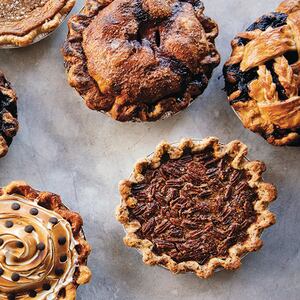As the days grow colder and shorter, autumn is the perfect season to enjoy one of the all-time classics, the Jack Rose. The drink is made with the quintessential fall crop, the good old apple. Indeed, long before Americans were making corn into bourbon, farmers in the Thirteen Colonies were making applejack, the principal component of this drink.
And while I’m raising a glass to the autumnal equinox, I’ll also be rereading Ernest Hemingway’s classic Lost Generation novel, The Sun Also Rises. Not only was the book published in the fall of 1926 but features the Jack Rose.
The Jack Rose is a pre-Prohibition gem, a classic three-part “sour” cocktail made with apple brandy/applejack, lemon or lime juice and grenadine. In his 1948 book The Fine Art of Mixing Drinks, David Embury deemed the Jack Rose to be one of the “Six Basic Cocktails,” along with the Martini, Manhattan, Sidecar, Daiquiri (another sour), and the Old Fashioned. Pretty esteemed company.
ADVERTISEMENT
You’ll see the Jack Rose mentioned as early as 1899; an item in the Chicago Inter Ocean from May 14, 1899, titled “Drinks in New York,” tells us that “Perhaps the most popular drink of the day is the whisky daisy, though the jack-rose is the pet of many connoisseurs.” The earliest recipe I’m aware of is found in Jack’s Manual on the Production, Care and Handling of Wines and Liquors, Storing, Binning and Serving (1908), by Jack Grohusko.
Jack’s version is slightly more complicated; in addition to the apple brandy and lime juice, it’s sweetened with both sugar and raspberry syrup, and flavored with a few dashes of orange juice and lemon juice. It’s quite nice, but you probably don’t need the added sugar.
There are several theories on the origin of the drink’s name: that it was so named because it’s made with applejack and has a rosy hue (from the grenadine) or, in a similar vein, that the drink is “so called because of its pink color, the exact shade of a Jacqueminot rose, when properly concocted,” as the drink is described in Albert Stevens Crockett’s 1931 classic, The Old Waldorf-Astoria Bar Book.
Another more colorful origin theory connects the drink to a notorious New York gambler Jacob Rosenzweig, who went by the nickname “Bald Jack Rose.” Rose was said to have been “such a Broadway personality that a cocktail was named after him,” according to the 2001 book Jazz Age Jews by Michael Alexander. Rose made headlines when he testified against a (presumably) crooked NYPD detective, Lieutenant Charles Becker, in the assassination of mob figure, Herman “Beansie” Rosenthal, in 1912. Becker was convicted and went to Sing Sing’s electric chair in 1915. However, I’m a bit dubious of the Bald Jack Rose theory. For starters, when the drink was first referenced in 1899, Jack was but 23 years old. He was probably still living in Norwich, Connecticut, and wasn’t yet the toast of Broadway, if he ever was.
But there was a connection between the gambler, roses and the drink, after all. Indeed, an item in the January 2, 1913, issue of the Des Moines Tribune, titled “Jack Rose Drink Fades From Bars,” bemoaned the fact that the murder trial’s notoriety had made it so that both florists and bartenders couldn’t sell roses and drinks bearing the rat’s, er, I mean star witness’s name. “The murder of Herman Rosenthal has affected the business of florists in Brooklyn. The Jack rose, a popular blossom, has been left on the hands of the Brooklyn florists, just because it bears the same name as the informant in the famous trial.” So, florists changed the name to the “New York rose.” As for the drink’s name, “There was a serious slump in cocktails which were known as Jack Roses. A Jack Rose is a cocktail which was guaranteed to cultivate a keen edge on one’s appetite. However, like the florists, the bartenders decided that perhaps under another name the Jack Rose cocktail might again become a good seller. Accordingly, they now call it a ‘royal smile.’”
As a caveat, note that the Royal Smile appeared in the 1911 book, Beverages de Luxe, by Washburne and Bronner, published one year before Beansie Rosenthal was gunned down and well before “Bald Jack” Rose was compelled to become an informer. Hmmm, these great cocktail stories often get ruined by pesky facts. So, it seems that bartenders simply took note of the two drinks’ similarity, and “adopted” the name of one drink as the “alias” of the other for a while, you know, until things cooled over. Kind of a cocktail witness protection program, I guess.
Somehow, the Jack Rose ultimately survived the murder trial’s stigma. I’m not sure I’ve ever seen a Royal Smile on anyone’s menu, although you will find a few references to it in cocktail books from the era, notably in Jacques Straub’s 1914 book Drinks, in Barflies and Cocktails from 1927, by Harry’s New York Bar owner Harry MacElhone and in Harry Craddock’s classic The Savoy Cocktail Book from 1930. (However, in the last two books, you’ll find both the Jack Rose and the Royal Smile, go figure?) In most of these books, the Royal Smile is more or less a Jack Rose with the addition of gin, dry vermouth and sometimes egg white.
Getting back to Hemingway, he saw fit to feature the drink twice within the pages of The Sun Also Rises. Both times the characters are drinking them at the Hôtel de Crillon in Paris. In a celebrated scene, Jake Barnes is waiting in vain for his lover Brett Ashley; the previous evening, she’d agreed to meet Jake at the hotel, but was probably too drunk that night to remember their date the next day. (Frustration in their relationship is a theme that runs throughout the book; after all, Jake’s war wound rendered him unable to consummate his love for Brett.) Anyway, Jake as the narrator tells us that “Brett did not turn up, so about quarter to six I went down to the bar and had a Jack Rose with George the barman.”
In another scene from The Sun Also Rises, Jake’s friend Bill Gorton has apparently had a few Jack Roses, also made by George at the Crillon. Perhaps more than a few—Jake notes that Bill was “pie-eyed,” and quips that Bill was “about a hundred and forty-four” drinks ahead of him.
George the barman and the Jack Rose were also mentioned in another novel from 1926, Mr. and Mrs. Haddock in Paris, France, by humorist Donald Ogden Stewart, who happened to know Hemingway. The book lampoons the typical, stodgy, stuffy Americans who ventured over to Europe to have a look around. It seems, however, that Mr. Haddock is more inclined to “live a little,” and “do as the Parisians do” than his wife, who’s a complete stick in the mud. One scene finds Mr. Haddock at the Ritz bar, “where he found a great many fine congenial Americans drinking and eating potato chips.”
One such Yank seemed to be especially friendly, and offered advice to Mr. Haddock. He claimed to have “‘seen everything – Luigi’s, Ciro’s, Zelli’s, New York bar, Crillon bar. Seen everything. The best place in Paris to get Jack Roses is at the Crillon,” he added. “Get George to mix them, do you know George?…The best bartender in Paris,” the young man assured Mr. Haddock.
While working on my new book, A Drinkable Feast: A Cocktail Companion to 1920s Paris, I got to thinking about the Jack Rose, wondering how it might have been made in 1920s Paris, how it might have tasted to Hemingway and Donald Ogden Stewart. Was it the same, simple three-part sour cocktail, made of applejack (or the local apple brandy Calvados), citrus and grenadine? Or did the bartenders of Paris offer their own creative interpretation? I found a number of more complicated Jack Rose recipes in cocktail books of the region. At Harry’s New York Bar, one of Hemingway’s favorite haunts, the drink was essentially a mashup of the Jack Rose with the Bronx, combining the former’s apple brandy, lime juice and grenadine with the latter’s sweet and dry vermouth, orange juice, and gin. And you know what? The damned thing tastes pretty good.
The aromatic quality of the vermouth reminds me of the Presidente, that famous rum cocktail of Cuba. The gin gives it backbone and dryness, and the orange juice balances out the tartness of the citrus. Just be careful with the grenadine–don’t make it too sweet.
So, I wonder if perhaps this version of the Jack Rose is what Jake Barnes was drinking while awaiting his star-crossed lover, Brett. A too-complicated drink for an inextricably-tangled relationship, seems quite fitting to me.
INGREDIENTS:
- 1.5 oz Applejack or calvados (try Laird’s new Applejack 86, it’s lovely)
- .75 oz Dry gin
- .75 oz Orange juice
- .75 oz Fresh lemon or lime juice
- .33 oz French vermouth
- .33 oz Italian vermouth
- Grenadine to color (about .33 oz)
- Glass: Cocktail
- Garnish: Lime or lemon peel twist
DIRECTIONS:
Add all the ingredients to a shaker and fill with ice. Shake, and strain into a chilled cocktail glass. Garnish with twist of lime or lemon peel.
Recipe adapted from Barflies and Cocktails.
For more tales from 1920s Paris, pick up Philip Greene’s new book, A Drinkable Feast: A Cocktail Companion to 1920s Paris, which comes out on October 16.







